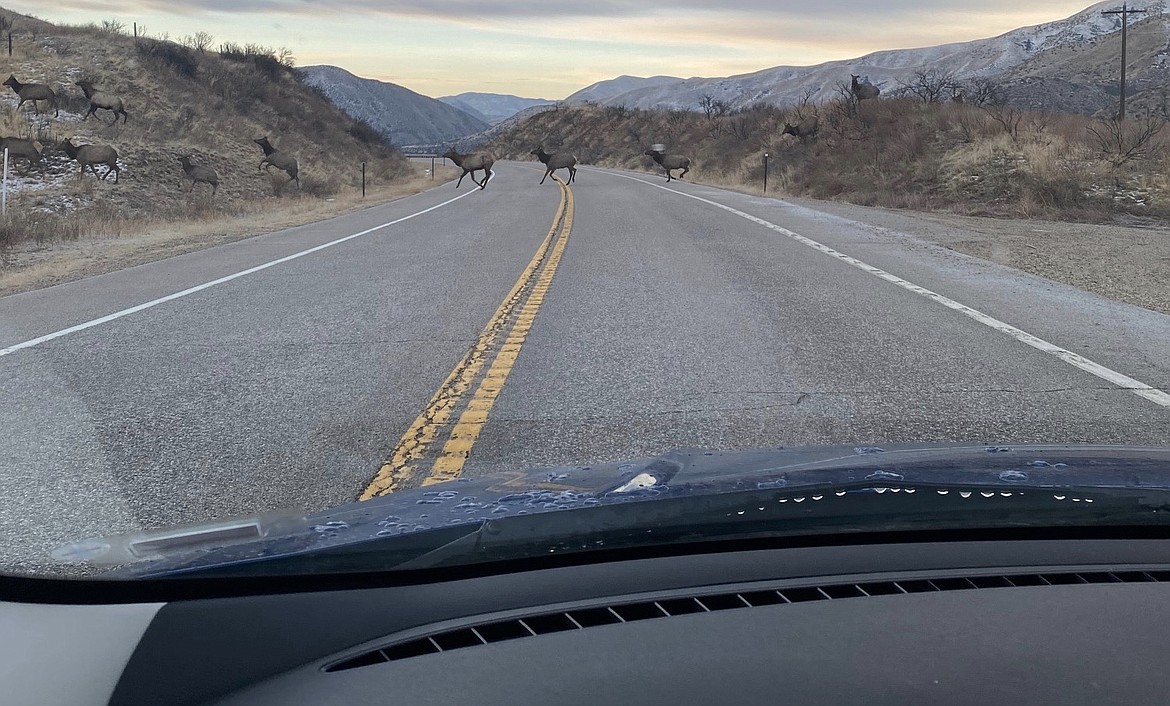Protect wintering wildlife by leaving animals undisturbed
Winter is a challenging season for Idaho’s wildlife, especially for big game animals that migrate to lower elevations and spend winter closer to people than during other seasons. People can help animals by leaving them undisturbed so they have a better chance to survive winter.
What do we know about wintering wildlife? Forage is limited, and animals usually can’t meet their full nutritional needs by feeding on naturally available forage even at lower elevations. Deer, elk and other big game animals accumulate fat reserves earlier in the year that typically allows them to survive most Idaho winters, but even the healthiest animals' limited reserves can be depleted, and fawns and calves are most susceptible to malnutrition and winterkill.
During a “normal” winter without extremely frigid temperatures, or unusually deep snow, typically more than 90 percent of adult deer and elk survive. But that number can be significantly lower for fawns and calves, which are smaller and less capable of withstanding winter conditions. On average, about 40 percent of mule deer fawns perish during a normal Idaho winter, and more during a harsh one, so leaving wildlife undisturbed can literally make a life-or-death difference.
Know the rules before you head out, and look for seasonal changes and forest closures, such as the recent closure of the Targhee National Forest in Eastern Idaho. Closures like this protect habitats where large populations of wintering deer and elk tend to be congregated. Not knowing is not an excuse. Review up-to-date maps and call your local forest service or Fish and Game office if you have questions.
Keep your dog under your control
Even if your dog isn’t chasing big game animals, its presence may be enough to cause animals to flee and expend unnecessary energy they would not have otherwise used.
To big game animals, a dog is a predator, and the impacts of free-running dogs on wintering game can be substantial. Also remember it is illegal to allow dogs to chase or harass big game.
Remember, you usually have lots of options where you can exercise your dog, but big game animals have few options where they can safely spend their winters.
Watch for big game while driving
Auto collisions involving big game animals typically increase during winter, especially around the holidays, so drivers should be extra cautious.
“Being watchful is the best defense against a wildlife/vehicle collision," said Krista Biorn, Fish and Game habitat biologist. "Drivers should slow down and allow a few extra minutes to their travel time for their own safety, and the safety of Idaho's wildlife.”
Collisions between vehicles and wildlife are not only harmful, they are expensive. Hitting a deer or elk often results in thousands of dollars in vehicle damage, not to mention potential injury to vehicle occupants and the loss of wildlife.
These tips will help reduce your chances of an animal collision:
Game animals are especially active at dawn, dusk and at night so be extra watchful and cautious during those periods.
Scan ahead and watch for movement, especially near the fog line and side of the road. When driving at night, use your brights when appropriate and watch for shining eyes in headlights.
If you see one animal cross the road, slow down immediately and look for more to follow.
Pay extra attention in areas posted with wildlife crossing signs, which signify common migration areas, or areas where big game winters.
Don't swerve and risk losing control of your vehicle. Brake as much as possible, but stay on the roadway. The most serious crashes often occur when drivers lose control of their vehicles while trying to avoid an animal.
Don’t feed wintering big game
It may seem counterintuitive when there’s limited food available for deer, elk and other animals, but feeding big game can cause big problems, even with good intentions.
Fish and Game’s policy is that natural habitat and feed must sustain wildlife, except in emergency situations. Regardless of the severity of winter, some animals will naturally perish. That's an inescapable part of nature, and animals too stressed from winter can die even when food is available.
When big game animals are fed by people, it can create a long list of problems. They can become habituated to hand outs, change natural migration patterns, damage property, create traffic hazards and attract predators such as mountain lions. Congregated animals can also more readily transmit diseases, such as brucellosis and chronic wasting disease, and create other problems.
If it’s an emergency situation, Fish and Game staff will feed animals
Fish and Game has winter feeding advisory committees in each region of the state except the Panhandle, which has never had a winter feeding program, and they are prepared to take action if an emergency situation arises.
The regional advisory committees monitor weather conditions and keep a watchful eye on snow depth. They also monitor whether there is crust on snow that hinders an animal’s ability to forage for food, extended periods of sub-zero temperatures, whether animals are congregating on private agriculture lands and causing problems, and other determining factors.
If these situations occur due to extreme winter weather, the committees convene and make recommendations to Fish and Game whether to begin emergency winter feeding.
Here's more information about Fish and Game's emergency winter feeding program.
Roger Phillips is the public information supervisor for Idaho Department of Fish & Game.
Video
Avoid Disturbing Wildlife in the Winter
One way to avoid disturbing wintering wildlife is simply leaving them alone when you’re outdoors. A simple rule of thumb is if your presence or actions cause them to move, you're too close.






